
IFPRI launches a new Google.org–funded initiative to strengthen early warning and anticipatory action systems
When drought lingers, when prices climb quietly in local markets, and when conflict disrupts the harvest, early warning matters. Yet the systems that have long helped the world anticipate hunger are under strain.
The U.S. Agency for International Development’s Famine Early Warning Systems Network (FEWS NET) once set the global standard for forecasting food crises months in advance. Together with the Integrated Food Security Phase Classification (IPC), these tools formed the backbone of famine prevention. But as international aid budgets tightened, their reach began to shrink. Data collection slowed. Updates became less frequent. For countries already teetering between crisis and stability, that loss of visibility can mean the difference between timely action and tragedy.
Amid these challenges, a new initiative is taking shape to fill the gap. With support from Google.org, IFPRI has launched Prediction of Food Crisis Risks—a project that combines artificial intelligence, satellite data, and economic modeling to strengthen early warning and anticipatory action systems. The project unites researchers from IFPRI, Cornell University, and Boston College, working alongside CGIAR partners to build a new generation of forecasting tools that can detect emerging hunger hotspots before they spiral out of control.
At the heart of the effort lies a simple idea: to make food crisis prediction faster, cheaper, and more precise. The team is designing machine-learning models that can forecast acute food insecurity—what the IPC classifies as Phase 3 or worse—up to a year in advance. Rather than relying only on costly and time-consuming field assessments, the models draw from a wide range of information sources, from weather and vegetation data captured by satellites to market prices, population patterns, and records of conflict events. Together, these layers of data create a real-time picture of how multiple shocks—climate, economic, and social—interact to shape hunger risk.
Early testing shows strong promise. When validated against historical IPC data, IFPRI’s model has correctly identified more than nine out of ten instances of severe food insecurity and has successfully anticipated most crisis events within a three- to twelve-month window. For researchers, the results offer both confidence and urgency. For humanitarian planners, they offer something even more valuable: time.
Dr. Yanyan Liu calls the approach “a complement, not a replacement” to existing systems like FEWS NET and IPC. In places where conflict or insecurity makes field data collection impossible, she explains, these models can help fill critical gaps: “a way to see what we otherwise cannot.” Yet she is quick to emphasize that technology alone is not enough. “We still need good data,” she says. “AI can only be as smart as the information we feed it.”
The project builds on several years of IFPRI’s research into predictive analytics for food security, and it expands that work into new directions. One stream focuses on Kenya, where IFPRI and partners are working with the National Drought Management Authority to analyze high-frequency data on malnutrition and food access. Another explores how price movements can serve as early warning signals of stress in markets across West Africa and the Sahel. A third combines satellite-based ecosystem modeling with machine learning to link crop yields, land management, and greenhouse-gas emissions—connecting food security forecasting with the broader climate agenda.
Together, these strands form a vision for what early warning could look like in the years ahead: systems that not only track where hunger is rising but explain why, offering governments and humanitarian agencies the evidence they need to act early and effectively.
For IFPRI and Google.org, the collaboration reflects a shared belief that technology should serve the public good. Artificial intelligence, used responsibly, can be a bridge between data and decision. By helping to forecast food crises before they unfold, it can give policymakers the lead time to safeguard lives and livelihoods.
As global challenges multiply and traditional aid budgets come under pressure, anticipation may be our most powerful tool. The Prediction of Food Crisis Risks project is a step toward that future where we can see the storm coming, and prepare before it hits.
